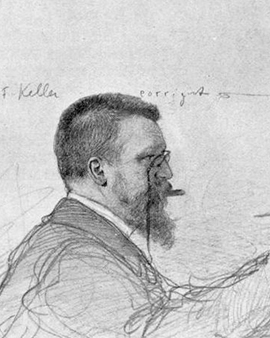


Ferdinand Keller, a name that shines among the luminaries of German history painting, invites us on a journey back in time to an era when art and history went hand in hand. Born in Karlsruhe on August 5, 1842, Keller was able to create an impressive oeuvre during his lifetime, captivating us with his detailed depictions and dramatic staging of historical events. With his monumental paintings, he shaped the style of historicism and left an everlasting impression on the world of fine arts. The first phase of Keller's artistic development was unexpectedly exotic in character. At only fifteen, he accompanied his father, a civil engineer, to Brazil, where he sketched the incomparable tropical landscape. These early experiences, which sharpened his eye for the detail and colorfulness of nature, had a profound effect on his later artistic vision.
After returning to Germany, Keller deepened his artistic skills at the renowned Karlsruhe Academy of Art. His teachers were none other than Johann Wilhelm Schirmer, the director of the Academy at the time, and Ludwig des Coudres. His tireless search for artistic excellence eventually led him to Rome, where he met the eminent painter Anselm Feuerbach and was inspired by the city's lush art scene. In 1870, Keller was appointed to teach portrait and history painting at the Karlsruhe Art Academy, a position he filled with dedication and commitment. Recognition of his work eventually led to his appointment as professor and later director of the academy, a role he held until 1913. His influence and leadership in the art world were confirmed by the numerous honors he received, including the naming of a street after him and the bestowal of the personal title of nobility by the King of Württemberg.
Keller's masterpieces are an ode to history. With his monumental works such as "Death of Philip II" and "The Apotheosis of Emperor Wilhelm I," he established himself as a master of history painting. He also created impressive works for the Karlsruhe Court Theater and the Dresden Court Theater, and his exquisite decoration of the King Karl Hall in the Stuttgart State Museum so delighted the King of Württemberg that he bestowed upon Keller the personal title of nobility. In recognition of this remarkable artist and his unique ability to bring history to life, we present high-quality art prints of Keller's works. Each art print is a meticulous reproduction that aims to preserve the originality and brilliance of Keller's painting. We invite you to discover the world of Ferdinand Keller, a world where history and art merge in perfect harmony.

Ferdinand Keller, a name that shines among the luminaries of German history painting, invites us on a journey back in time to an era when art and history went hand in hand. Born in Karlsruhe on August 5, 1842, Keller was able to create an impressive oeuvre during his lifetime, captivating us with his detailed depictions and dramatic staging of historical events. With his monumental paintings, he shaped the style of historicism and left an everlasting impression on the world of fine arts. The first phase of Keller's artistic development was unexpectedly exotic in character. At only fifteen, he accompanied his father, a civil engineer, to Brazil, where he sketched the incomparable tropical landscape. These early experiences, which sharpened his eye for the detail and colorfulness of nature, had a profound effect on his later artistic vision.
After returning to Germany, Keller deepened his artistic skills at the renowned Karlsruhe Academy of Art. His teachers were none other than Johann Wilhelm Schirmer, the director of the Academy at the time, and Ludwig des Coudres. His tireless search for artistic excellence eventually led him to Rome, where he met the eminent painter Anselm Feuerbach and was inspired by the city's lush art scene. In 1870, Keller was appointed to teach portrait and history painting at the Karlsruhe Art Academy, a position he filled with dedication and commitment. Recognition of his work eventually led to his appointment as professor and later director of the academy, a role he held until 1913. His influence and leadership in the art world were confirmed by the numerous honors he received, including the naming of a street after him and the bestowal of the personal title of nobility by the King of Württemberg.
Keller's masterpieces are an ode to history. With his monumental works such as "Death of Philip II" and "The Apotheosis of Emperor Wilhelm I," he established himself as a master of history painting. He also created impressive works for the Karlsruhe Court Theater and the Dresden Court Theater, and his exquisite decoration of the King Karl Hall in the Stuttgart State Museum so delighted the King of Württemberg that he bestowed upon Keller the personal title of nobility. In recognition of this remarkable artist and his unique ability to bring history to life, we present high-quality art prints of Keller's works. Each art print is a meticulous reproduction that aims to preserve the originality and brilliance of Keller's painting. We invite you to discover the world of Ferdinand Keller, a world where history and art merge in perfect harmony.
Page 1 / 1






